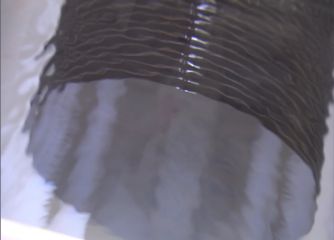Home > Press > Nanotechnological innovations can improve water
 |
Abstract:
Research teams are trying different approaches within the nanotechnological field to improve water membrane technologies. One of these is to improve water purification by using nature's own water-transporting channels, aquaporins. However, constructing suitable membranes for industrial processes is a challenge.
Nanotechnological innovations can improve water
Italy | Posted on May 13th, 2011Membranes for water purification are used in many applications and different types of membranes are being developed at the moment. No membrane can filter and purify water entirely, but improvements using novel kinds of membranes are made.
In the European Commission-funded project MEMBAQ (Incorporation of Aquaporins in Membranes for Industrial Applications) researchers are taking advantage of a unique structure nature has already created, when they are developing a nanotechnological invention. They are inspired by the cell membranes' water-transporting channels made up of proteins called aquaporins. Only pure H2O molecules are let through. Different kinds of water filtration membranes have been incorporated with these aquaporins, in the pursuit of a revolutionary nanobiotechnological water membrane technology that can remove particles and pathogens from the water much more efficiently, compared to other membranes on the market.
The main challenge at the moment is to make membranes applicable to industrial processes. However, the scientists have come a long way by supporting the aquaporins with a flexible and tissue-like hydrogel layer and then stabilizing this layer with a perforated Teflon film, capable of holding hydrogel and aquaporin droplets. The project's aim is to develop membranes capable of, for example, recycle wastewater into drinking water and desalinate water. In addition, this technology could serve customers working on semiconductors, since they use a lot of ultra pure water, and might make this industry greener by reducing the energy needed during the water purification process. If everything goes according to plans, the customers will be offered a membrane that is five to ten times more efficient than membranes currently available on the market.
Another way of improving water purification through a nanotechnological approach has been developed by researchers at Stanford University. They have electrified a cotton membrane, coated with silver nanowires and nanotubes, to kill pathogens. This electrical mechanism is used instead of size exclusion. The bigger pores let the water flow through about 80,000 times faster than bacteria-trapping membranes allow and also make it possible to avoid clogging of the membranes. Multiple filter stages are needed, since one electrified membrane only kills 98 percent of the pathogens. The researchers have shown that the electricity required to run current through the membrane could be as low as a fifth of a filtration pump's energy need, when a comparable water amount is let through.
The market for different membranes that can purify water is growing and customers might soon have the possibility to pick a membrane that better suit their needs.
####
For more information, please click here
Contacts:
Elisabeth Schmid
Phone: +39 0272002572
Fax: +39 0272002540
E-mail:
Copyright © youris.com
If you have a comment, please Contact us.Issuers of news releases, not 7th Wave, Inc. or Nanotechnology Now, are solely responsible for the accuracy of the content.
| Related News Press |
News and information
![]() Researchers develop molecular qubits that communicate at telecom frequencies October 3rd, 2025
Researchers develop molecular qubits that communicate at telecom frequencies October 3rd, 2025
![]() Next-generation quantum communication October 3rd, 2025
Next-generation quantum communication October 3rd, 2025
![]() "Nanoreactor" cage uses visible light for catalytic and ultra-selective cross-cycloadditions October 3rd, 2025
"Nanoreactor" cage uses visible light for catalytic and ultra-selective cross-cycloadditions October 3rd, 2025
Govt.-Legislation/Regulation/Funding/Policy
![]() New imaging approach transforms study of bacterial biofilms August 8th, 2025
New imaging approach transforms study of bacterial biofilms August 8th, 2025
![]() Electrifying results shed light on graphene foam as a potential material for lab grown cartilage June 6th, 2025
Electrifying results shed light on graphene foam as a potential material for lab grown cartilage June 6th, 2025
![]() Institute for Nanoscience hosts annual proposal planning meeting May 16th, 2025
Institute for Nanoscience hosts annual proposal planning meeting May 16th, 2025
Discoveries
![]() Researchers develop molecular qubits that communicate at telecom frequencies October 3rd, 2025
Researchers develop molecular qubits that communicate at telecom frequencies October 3rd, 2025
![]() Next-generation quantum communication October 3rd, 2025
Next-generation quantum communication October 3rd, 2025
![]() "Nanoreactor" cage uses visible light for catalytic and ultra-selective cross-cycloadditions October 3rd, 2025
"Nanoreactor" cage uses visible light for catalytic and ultra-selective cross-cycloadditions October 3rd, 2025
Announcements
![]() Rice membrane extracts lithium from brines with greater speed, less waste October 3rd, 2025
Rice membrane extracts lithium from brines with greater speed, less waste October 3rd, 2025
![]() Researchers develop molecular qubits that communicate at telecom frequencies October 3rd, 2025
Researchers develop molecular qubits that communicate at telecom frequencies October 3rd, 2025
![]() Next-generation quantum communication October 3rd, 2025
Next-generation quantum communication October 3rd, 2025
![]() "Nanoreactor" cage uses visible light for catalytic and ultra-selective cross-cycloadditions October 3rd, 2025
"Nanoreactor" cage uses visible light for catalytic and ultra-selective cross-cycloadditions October 3rd, 2025
Water
![]() Taking salt out of the water equation October 7th, 2022
Taking salt out of the water equation October 7th, 2022
Research partnerships
![]() Lab to industry: InSe wafer-scale breakthrough for future electronics August 8th, 2025
Lab to industry: InSe wafer-scale breakthrough for future electronics August 8th, 2025
![]() HKU physicists uncover hidden order in the quantum world through deconfined quantum critical points April 25th, 2025
HKU physicists uncover hidden order in the quantum world through deconfined quantum critical points April 25th, 2025
|
|
||
|
|
||
| The latest news from around the world, FREE | ||
|
|
||
|
|
||
| Premium Products | ||
|
|
||
|
Only the news you want to read!
Learn More |
||
|
|
||
|
Full-service, expert consulting
Learn More |
||
|
|
||








